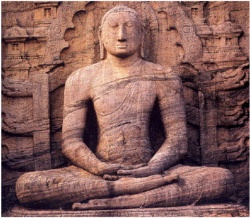Sanskrit
Sanskrit means ‘polished’ or ‘refined’ and is the name of the classical language of India. The sacred scriptures of Hinduism and also of Mahāyāna and Vajrayāna Buddhism were composed in Sanskrit, while the Tipiṭaka of Theravāda Buddhism was composed in Pāḷi. The two languages have much in common, but Sanskrit has a more complex grammar and a larger vocabulary than Pāḷi. Further, Sanskrit evolved its own script, called Devanāgarī, while Pāḷi has no specific script. Even at the time of the Buddha, Sanskrit was spoken only in the royal court and by priests and intellectuals, and for this reason the Buddha refused to have his sermons rendered into Sanskrit (Vin.II,139). He wanted his teachings to be accessible to all, not just to a small elite.
History of Classical Sanskrit Literature, S. Bhattacarji, 1993.
Sanskrit (संस्कृतम् saṃskṛtam sə̃skɹ̩t̪əm, originally संस्कृता वाक् saṃskṛtā vāk, "refined speech"), is a historical Indo-Aryan Language, the primary liturgical Language of Hinduism and a literary and scholarly Language in Buddhism and Jainism. Today, it is listed as one of the 22 scheduled languages of India and is an official Language of the state of Uttarakhand. Sanskrit holds a prominent position in Indo-European studies.
The corpus of Sanskrit literature encompasses a rich tradition of Poetry and drama as well as scientific, technical, philosophical and Dharma texts. Sanskrit continues to be widely used as a ceremonial Language in Hindu religious Rituals and Buddhist practice in the forms of hymns and Mantras. Spoken Sanskrit is still in use in some villages, a few traditional institutions in India and there are many attempts at further popularization.
Classical Sanskrit is the standard register as laid out in the grammar of Pāṇini, around the 4th century BCE. Its position in the cultures of Greater India is akin to that of Latin and Greek in Europe and it has significantly influenced most modern languages of the Indian subcontinent, particularly in India, Pakistan, Sri Lanka and Nepal.
The pre-Classical Form of Sanskrit is known as Vedic Sanskrit, with the Language of the Rigveda being the oldest and most archaic stage preserved, its oldest core dating back to as early as 1500 BCE. This qualifies Rigvedic Sanskrit as one of the oldest attestations of any Indo-Iranian Language, and one of the earliest attested members of the Indo-European languages, the family which includes English and most European languages.
Sanskrit, as defined by Pāṇini, had evolved out of the earlier "Vedic" Form. The beginning of Vedic Sanskrit can be traced as early as 1500–1200 BCE (for Rig-vedic and Indo-Aryan superstrate in Mitanni). Scholars often distinguish Vedic Sanskrit and Classical or "Pāṇinian" Sanskrit as separate 'dialects'. Though they are quite similar, they differ in a number of essential points of phonology, vocabulary, grammar and syntax. Vedic Sanskrit is the Language of the Vedas, a large collection of hymns, incantations (Samhitas), theological and religio-philosophical discussions in the Brahmanas and Upanishads.
Modern linguists consider the metrical hymns of the Rigveda Samhita to be the earliest, composed by many authors over several centuries of oral tradition. The end of the Vedic period is marked by the composition of the Upanishads, which Form the concluding part of the Vedic corpus in the traditional view; however the early Sutras are Vedic, too, both in Language and content. Around the mid-1st millennium BCE, Vedic Sanskrit began the transition from a first Language to a second Language of Religion and learning. Classical Sanskrit
For nearly 2,000 years, a cultural order existed that exerted influence across South Asia, Inner Asia, Southeast Asia, and to a certain extent, East Asia. A significant Form of post-Vedic Sanskrit is found in the Sanskrit of the Hindu Epics—the Ramayana and Mahabharata. The deviations from Pāṇini in the epics are generally considered to be on account of interference from Prakrits, or "innovations" and not because they are pre-Paninean. Traditional Sanskrit scholars call such deviations ārṣa (आर्ष), meaning 'of the ṛṣis', the traditional title for the ancient authors. In some contexts, there are also more "prakritisms" (borrowings from common speech) than in Classical Sanskrit proper. Buddhist Hybrid Sanskrit is a literary Language heavily influenced by Middle Indic, based on early Buddhist prakrit texts which subsequently assimilated to the Classical Sanskrit standard in varying degrees.
According to Tiwari (1955), there were four principal dialects of classical Sanskrit: paścimottarī (Northwestern, also called Northern or Western),madhyadeśī (lit., middle country), pūrvi (Eastern) and dakṣiṇī (Southern, arose in the Classical period). The predecessors of the first three dialects are even attested in Vedic Brāhmaṇas, of which the first one was regarded as the purest (Kauṣītaki Brāhmaṇa, 7.6).

